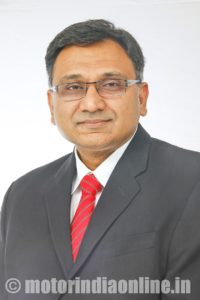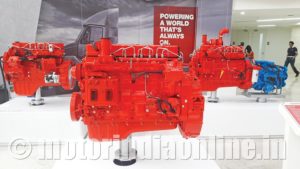Cummins is the largest independent powertrain supplier for CVs internationally, and actively engages in all forms of emerging technologies that drive the bus world towards a better and cleaner transport. In India, it is at the forefront of our bus industry, powering thousands of city buses and inter-city coaches running across the length and breadth of the country. It has grown into a ‘one-stop-solution’ for leading bus makers on engineering and powertrain management for over 25 years. Its products have demonstrated a high records of reliability, durability, easy maintainability, trouble free operations, and sustainable performance. The company continues to pursue various initiatives to bring global technologies which are best fit for the Indian bus market, especially with the BS-VI emission norms kicking-in in 2020.

With that objective and global technical capabilities in mind, MOTORINDIA interacted with Mr. Ashwath Ram, VP – Engine Business, Cummins India ABO, and MD at Tata Cummins Pvt. Ltd., on the evolution of bus industry in recent times and related technological developments. Here are the excerpts and responses:
Bus industry in India – Recent developments
Buses in India are evolving in a big way to provide better ride comfort, faster and safer passenger commute, in pursuit of an efficient mass transportation system. Buses now offer comfort features like air-conditioning, pneumatic suspension and tilt and roll prevention features. They are also getting faster and safer, thanks to powerful brakes and better engines. We are the leader in engine technology and are committed in providing engines that meet these emerging parameters, while consuming lower fuel.
Presently, we supply engine of 130-300 hp power ratings for buses of Tata Motors, VECV, and other leading OEMs in the country, meeting BS-IV emission norms. Cummins is working on upgrading these to BS-VI by year 2020. We have projects with over 500 engineers working in our technology center in Pune developing these new products. To leverage global technical capabilities and experience, the Pune team is working along with Cummins global development teams based in the US, the UK and China.
BS-VI – What to expect?
A lot of technology is going into the BS-VI engines, including plethora of sensors, sophisticated ECM (Engine Control Modules) that has all kinds of telematics features enabled, finer filtration, more capable electronic-controlled turbo chargers, advanced SCR system that interacts with ECM, and so on. The electronics is cardinal to sensors in subsystems, as they provide feedback to the various other engine components to optimize their working in real time. This has increased the technical complexity of the engines by 10 times to the current BS-IV engines.
With engines already going electronic, we would see the impact of the same on the entire powertrain including the transmission. It will now be easier to integrate fully-automatic or AMT techs to harness the best out of them. This would be the next trend to pick up.
Learnings from BS-IV
Bus market was the quite early in embracing BS-IV emission norms, with 13 cities complying way back in 2014. This was three years ahead of the norms being mandated to other medium and heavy commercial vehicles. This was a major shift in engine architecture, as engines become electronic-governed from being mechanical. Early adoption gave time to test new electronic products and optimize them. Another learning is the need to test run more mileage under local conditions, to deliver a dependable product to suit varying operating conditions. These lessons are now being applied for BS-VI to develop robust products for buses.
Tech adoption in India
The adoption rate of new technologies in India has been slower than in countries like China, Europe. This is mainly because the customers here are very cost conscious and the road infrastructure still doesn’t support some of the higher performance products that are used in the advanced nations.
Most of the OEMs today are offering global technologies to make the bus commute safer, faster and comfortable. With improvement in National highways and Government focusing on passenger safety, through the implementation of bus body code, we foresee the adoption rate of some of these technologies going forward in the coming years.
Hybridization and electrification of buses
Electrification will happen first in buses, especially in cities with less than 150 kms of running per day. China is leading the world in terms of the number of e-buses running, while others are also planning to scale up. Currently, e-buses are highly subsidized by the governments to make them commercially viable. However, as battery prices are expected to drop over the next ten years, they may emerge as commercially sustainable without interventions. Cummins is heavily investing in electric technology, and now has an Electric Power Business Unit. Our company will come up with suitable products in the international market by 2019.
On alternative fuels front, the biggest challenge remains to be their availability. For instance, city buses in India have seen massive CNG endorsements, but for inter-city applications, seamless availability of fuel is a critical. Cummins is “fuel” agnostic and has leading products for all types of fuels like CNG, LNG and bio-fuels.
“Electronics has increased the technical complexity of the engines by 10 times to the current BS-IV engines.
– Mr. Ashwath Ram
Cummins electric powertrain system unveiled
At the Busworld Turkey 2018 held at Izmir earlier this year, Cummins introduced an electric system for buses, which is configurable for either a full battery electric vehicle (BEV) or a range extended electric vehicle (REEV) bus platforms. Standardized on a new Cummins 74-kWh battery pack with space-efficient packaging, the system boasts a drive range up to 385 km on a single charge.
The new product complements the company’s already existing Euro VI clean diesel, natural gas and conventional hybrid powertrains for buses. Cummins is also emerging big time in developing Li-ion battery technology with a high energy density and proprietary control to sustain longer zero emission range in electric CVs.
